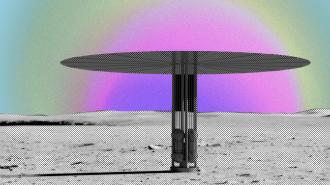NASA and the Department of Energy (DOE) have given three companies $5 million each to make it possible to put nuclear power on the moon by 2031 — and potentially provide future Mars colonists with tons of reliable electricity.
The challenge: It’s been 50 years since NASA last sent astronauts to the moon as part of its Apollo missions, and none of those visits lasted more than 12 days.
The moon-based reactor will need to provide 40 kilowatts of power for at least 10 years.
Through its Artemis missions, the agency plans to return humans to the moon as soon as three years from now — 2025. This time, it wants to establish a long-term presence there, so astronauts have plenty of time to explore the lunar surface and conduct research that could one day help us reach Mars.
Astronauts will need a reliable source of power while on the moon, and while solar panels can help meet that need, they won’t work during the long lunar nights or underground — and subterranean lava tubes are among the moon’s most scientifically intriguing features.
Nuclear option: More than a decade before NASA astronauts first set foot on the moon, people here on Earth were building massive power plants that used nuclear fission — the process of splitting atoms to release energy — to generate clean, weather-independent electricity.
Nuclear reactors don’t have to be massive, though. In November 2021, NASA and the DOE solicited proposals from US companies for “mini” reactor concepts theoretically capable of generating nuclear power on the moon.
The reactors would need to be lightweight and capable of continuously providing astronauts with 40 kilowatts of power — enough for 30 households here on Earth — for 10 years. They would also need to be ready for an actual demonstration on the moon by 2031.
On July 21, NASA and the DOE announced that they were giving three companies — IX, Westinghouse, and Lockheed Martin — each approximately $5 million to further develop their submitted design concepts over the next 12 months.
“The Fission Surface Power project is a very achievable first step toward the United States establishing nuclear power on the moon,” said John Wagner, director of the DOE’s Idaho National Laboratory. “I look forward to seeing what each of these teams will accomplish.”
The big picture: Like so many of NASA’s endeavors, there’s no established blueprint for generating nuclear power on the moon — the agency and its partners will have to learn as they go, and the project could fail at any stage of development.
If it’s a success, though, a moon-based fission reactor could not only give astronauts a way to power their tech on the lunar surface, but also lay the groundwork for generating electricity on Mars and beyond — helping make humanity a multi-world species.
We’d love to hear from you! If you have a comment about this article or if you have a tip for a future Freethink story, please email us at tips@freethink.com.
